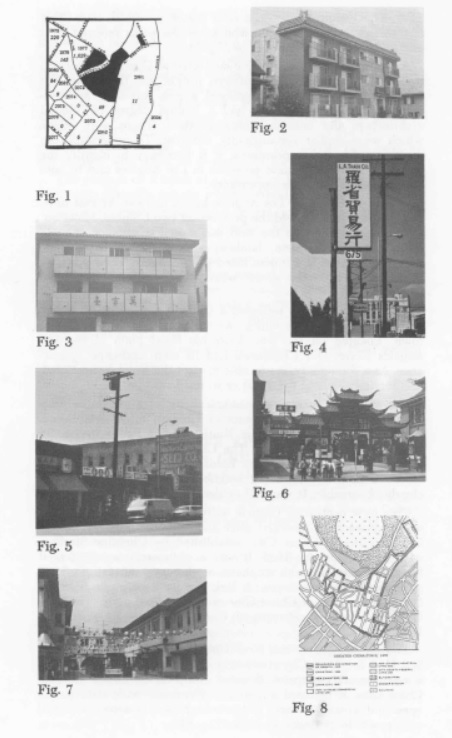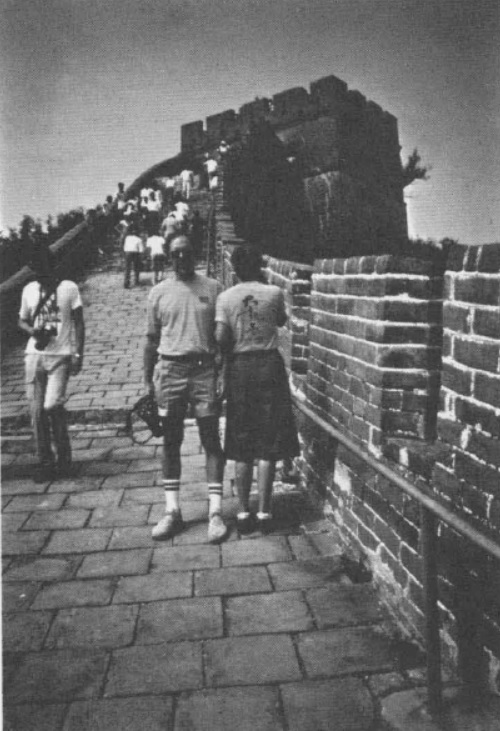By Thomas A. McDannold
Tom McDannold is a member of the Chinese Historical Society of Southern California. He is an Associate Professor of Earth Sciences at Ventura College, Ventura, California. Dr. McDannold has a continuing interest in the Chinese impact on the landscape of California.
In 1970, it was possible to clearly identify a center of Chinese population within the downtown area of Los Angeles. The identification could be accomplished in two ways. First, a mapping of U.S. Census Bureau data revealed a region where over 50% of the population was Chinese. (Fig. 1) The second method of identifying the Chinese concentration was to observe the downtown landscape – to see the familiar in a new way. The landscape view is the focus of the following pages.
In the downtown area, even a casual observer saw a geographic region identifiable by its Chinese appearance. It was characterized a distinctive architectural style (Fig. 2), use of Chinese characters (Fig. 3), and signs written in the Chinese language (Fig. 4). Overall, there was a clear Statement which said, “This is Chinese territory.” Those who knew the place referred to it as the Greater Chinatown of Los Angeles.
A close look at the distinctive landscape of Greater Chinatown indicated differences which offered insight into the locale. For example, some structures displayed a rich “oriental” architectural style. Other buildings had a limited degree of oriental architecture and minimum ornamentation. There were others which were similar yet distinctly different. To understand the various styles and appearances, it is necessary to identify the earliest persistent Chinese presence in Los Angeles and to note the associated landscape appearance.
Chinese presence in Los Angeles began in 1850. At that time, the U.S. census indicated the presence of two Chinese. However, their visual imprint on the land was most likely minor. A more clear, albeit incomplete, landscape record comes from 1860 when there were 15 Chinese listed in the census. Their presence could be seen on the streets where they wore the traditional clothes of China.
The 1890 landscape reflected a Chinese dominance in a particular geographic area which came to be known as Old Chinatown. Located on the less desirable flood plain of the Los Angeles River, Old Chinatown had its own landscape appearance. As a community, it was able to meet the social, recreational, and service needs of the 2,000 or so residents.
However, the emerging economic activity of vegetable marketing prompted another center of Chinese to be established. The settlement was located at Ninth and San Pedro Streets. Its focus was the City Market. The City Market was a vegetable produce center established by Louis Gwan in 1909. As Chinese moved into the surrounding neighborhood, their presence was clearly observable. It was still evident in 1970 (Fig. 5).
Two new centers of Chinese activity with a distinctive landscape appearance emerged after the mid-1930’s destruction of Old Chinatown. China City, established by Christine Sterling, was in operation by 1940. It was a commercial area oriented toward tourism with an emphasis on the ‘mystery of the orient” and associated stereotypes. A lack of tourist enthusiasm and a fire in the center of China City caused its final demise in 1949. Only architectural remnants of China City were to be seen in 1970.
The second center was New Chinatown. Conceived by Peter Soo Hoo Sr., New Chinatown was in full swing by 1940. It was a commercial enterprise directed towards the tourist. Unlike China City, it featured a modem appearance, wide streets with open and airy shops and restaurants. New Chinatown was still very much in evidence in 1970 (Fig. 6).

The look of New Chinatown was complicated by the construction of an additional structure. Although started in the early 1940’s, the addition remained unfinished because of World War II. Completed in the early 1950’s, it was characterized by a sameness of design (1,200 square feet, basement, commercial area with living quarters upstairs) and little ornamentation (Fig. 7).
The area between China City and New Chinatown began to be intensively occupied by Chinese during the 1950’s and 1960’s. Although the influx was slow, the new arrivals displayed their use of the area with an increase in the number of Chinese language signs.
In summary, the Greater Chinatown of 1970 consisted of the remnants of China City with its distinctive yet different oriental architectural style. Also included was New Chinatown with its ornate architecture and the more modest 1950 addition. The infilling of the area between China City and New Chinatown gave a visual unity to the entire area (Fig. 8). The end result was a unique collage of landscape indicators that represented the long term presence of the Chinese in downtown Los Angeles.

